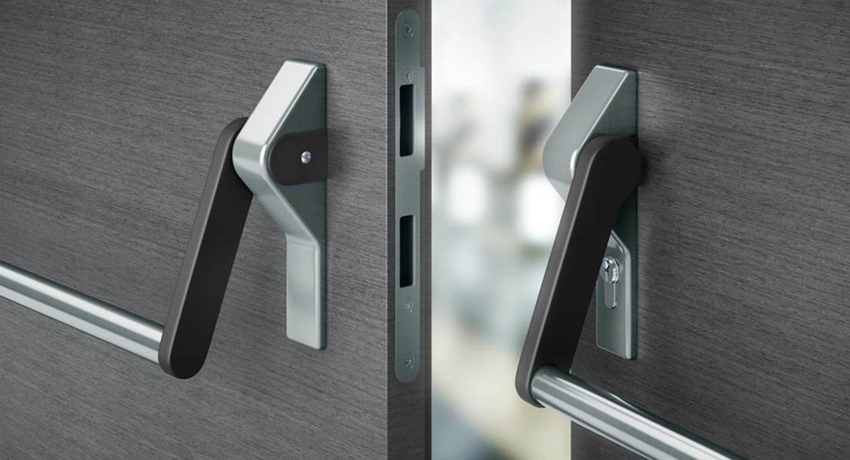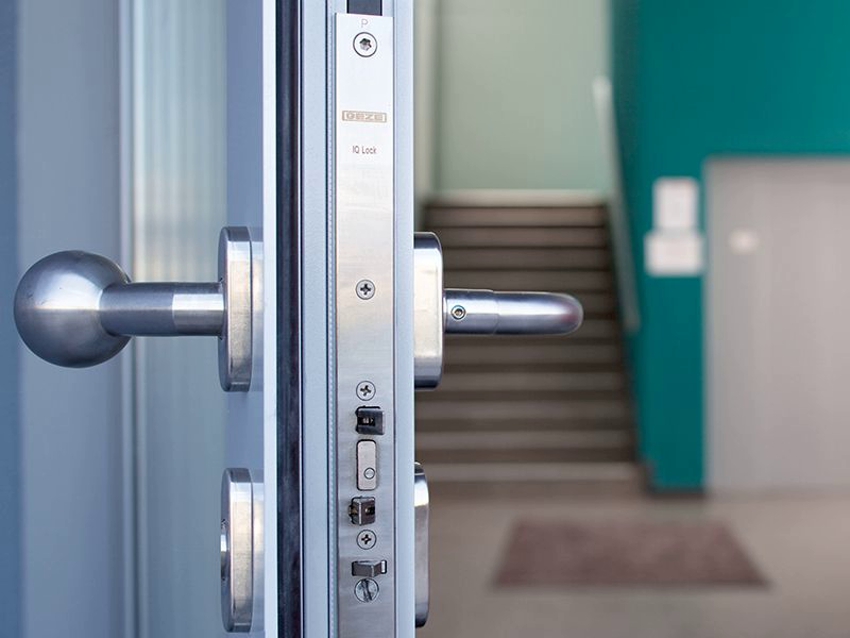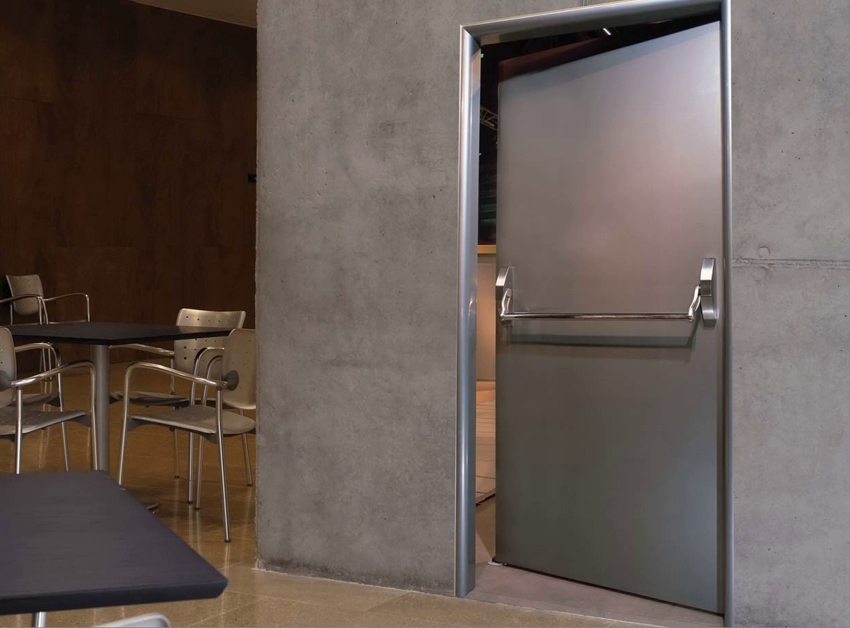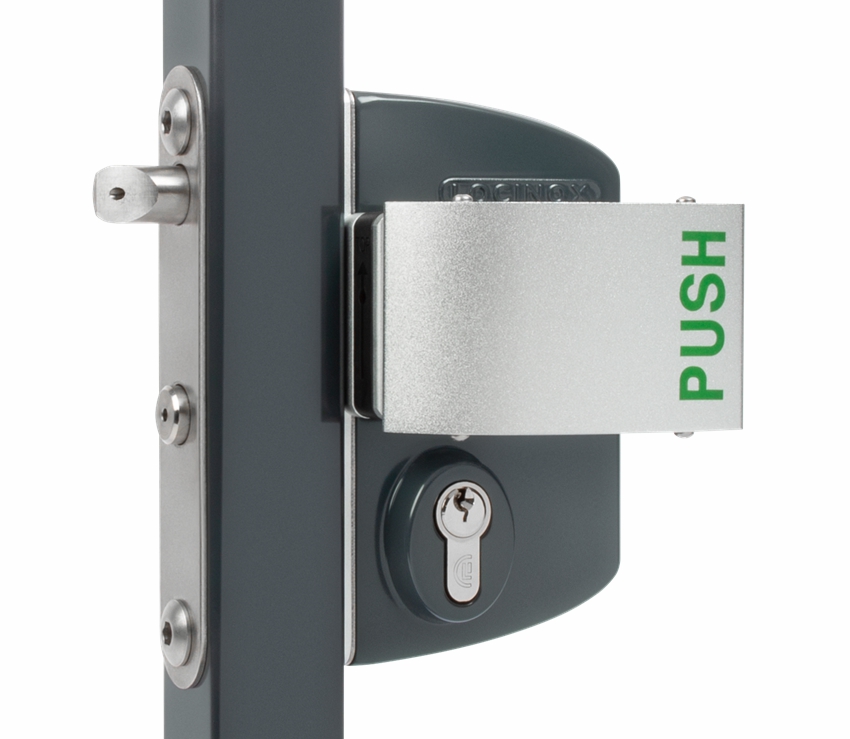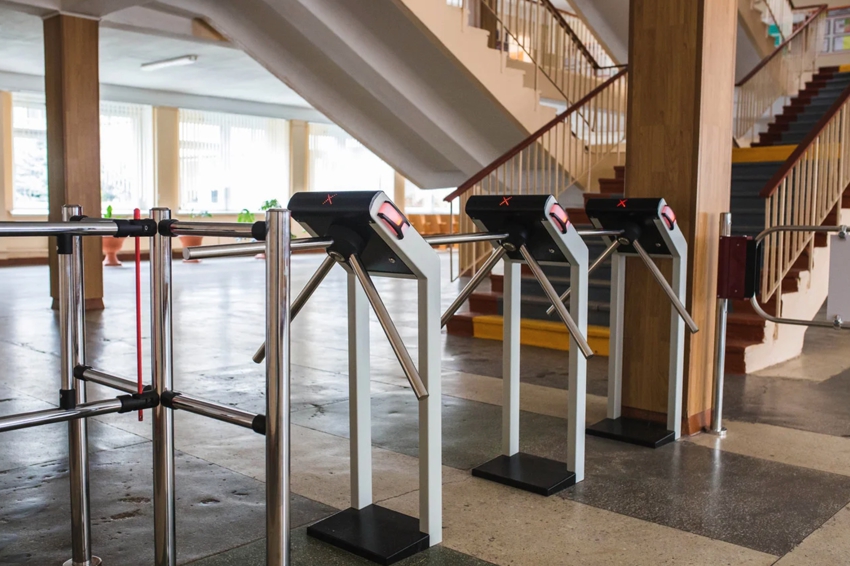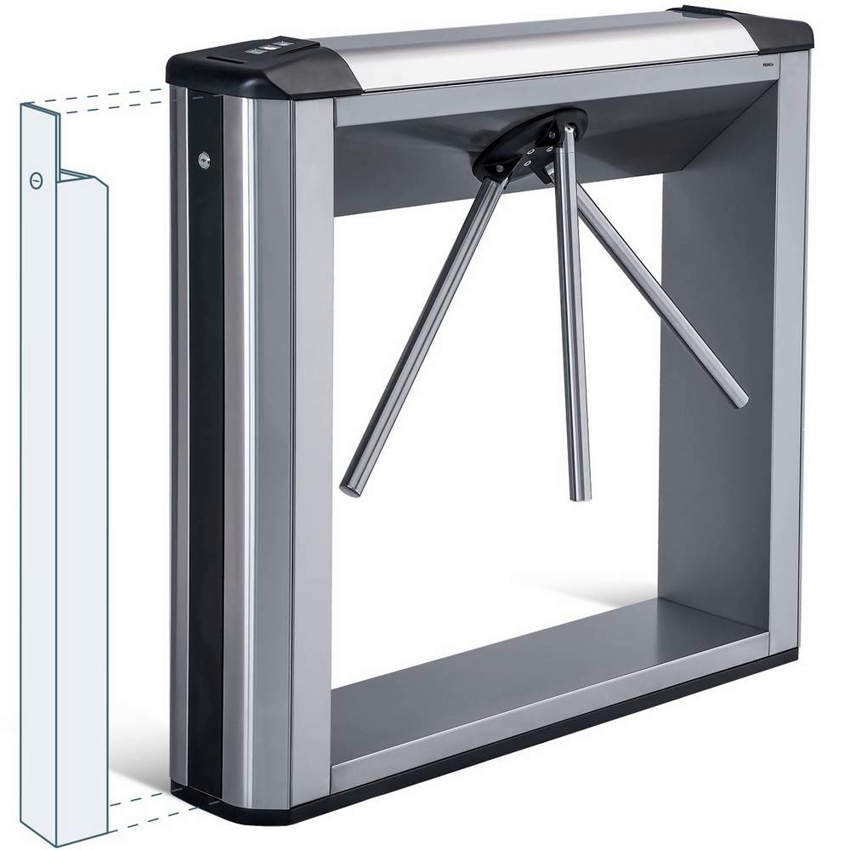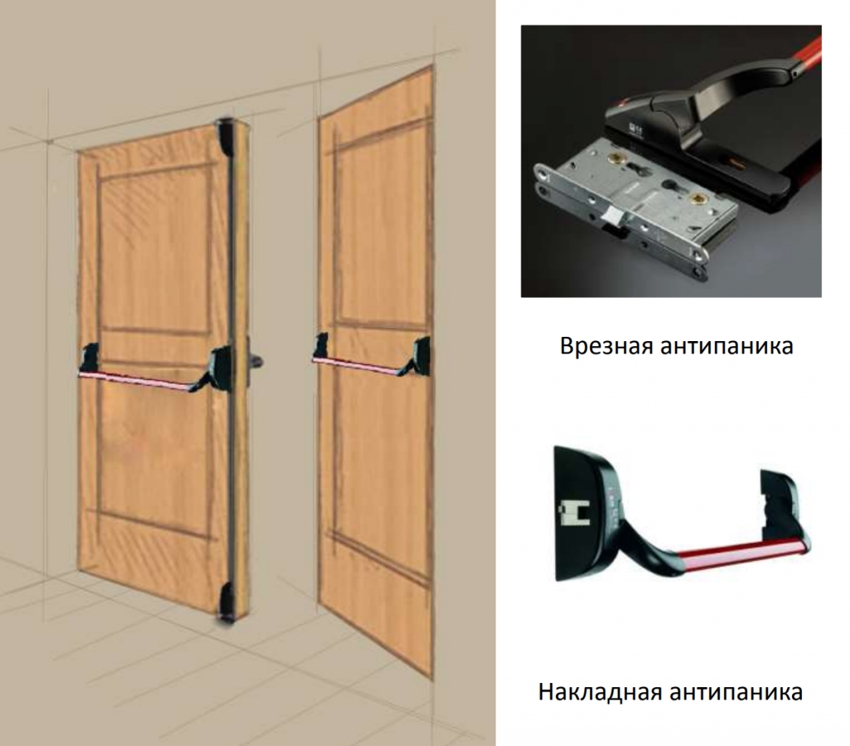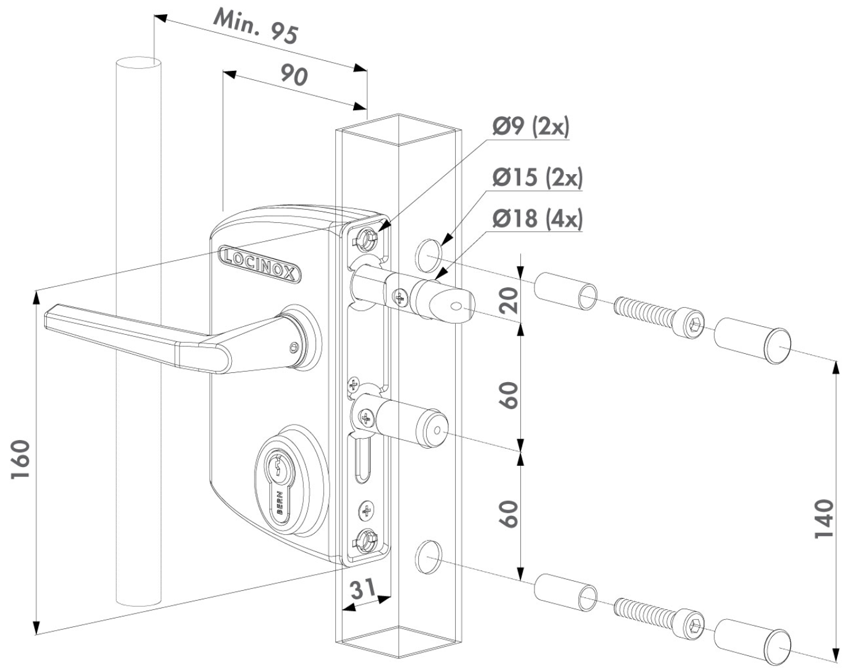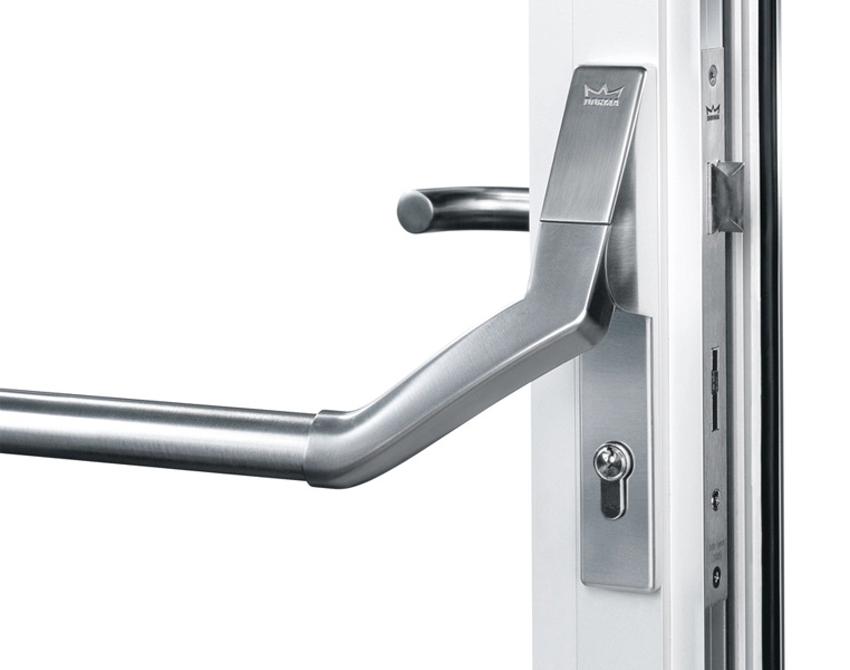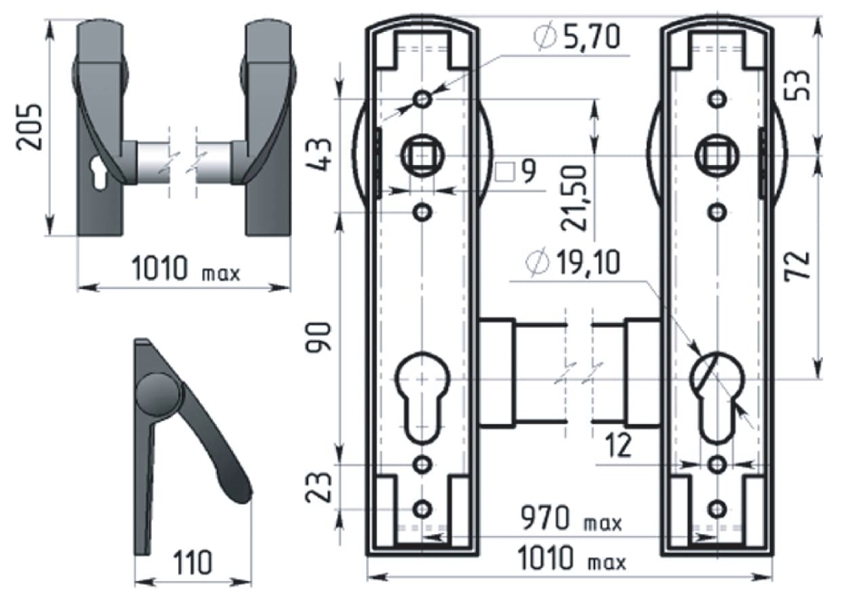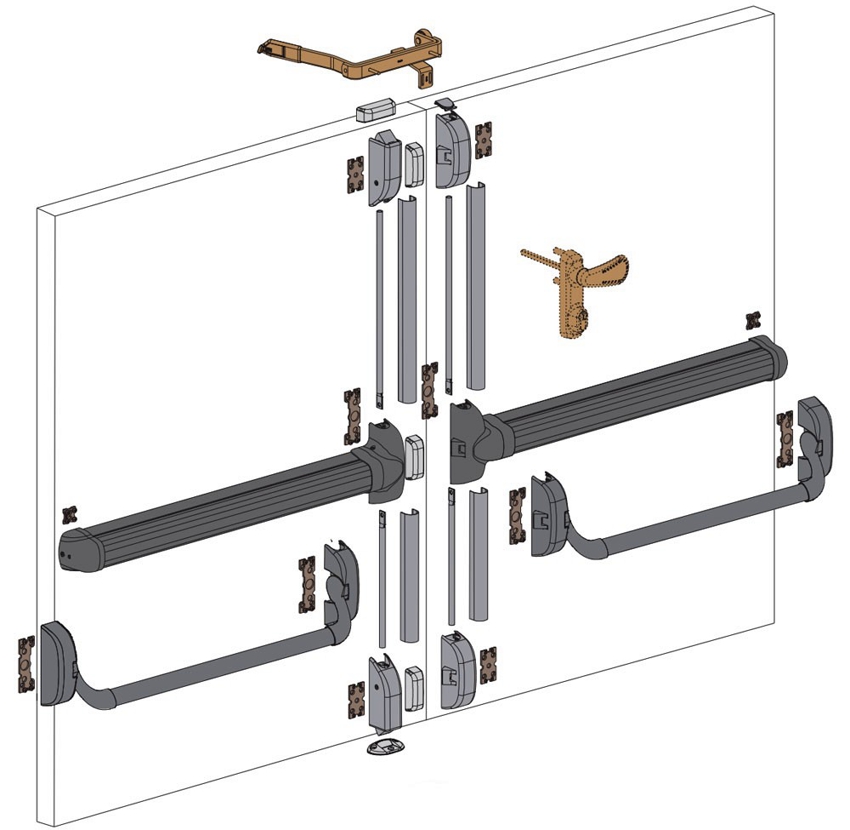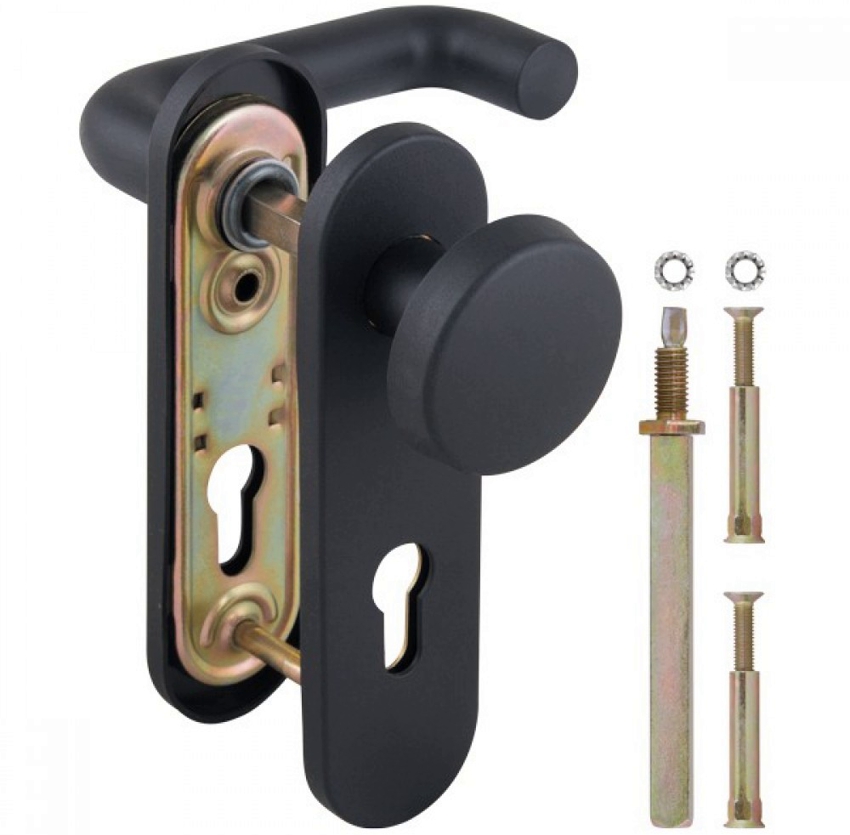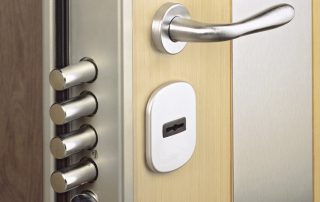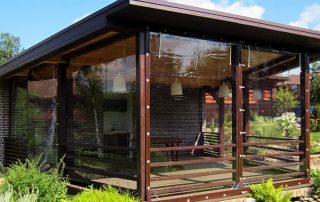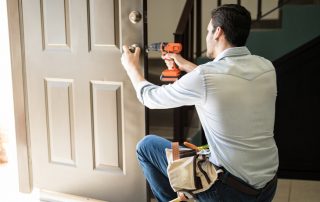The Anti-panic handle allows you to reduce the time for evacuation and timely save people from fire. In case of emergencies and dangerous situations, this system is simply irreplaceable. The article will help you understand all the features of such products, study their structure and principle of operation. Using this information, you can choose the best system for an emergency exit or fire door, as well as the best installation method.
Content
Anti-panic system: what it is and what it is used for
Anti-panic is a security locking system designed for emergency opening of doors and passages in case of emergencies (explosion, fire, smoke, fire, etc.). Installation is carried out in public places where large numbers of people gather.
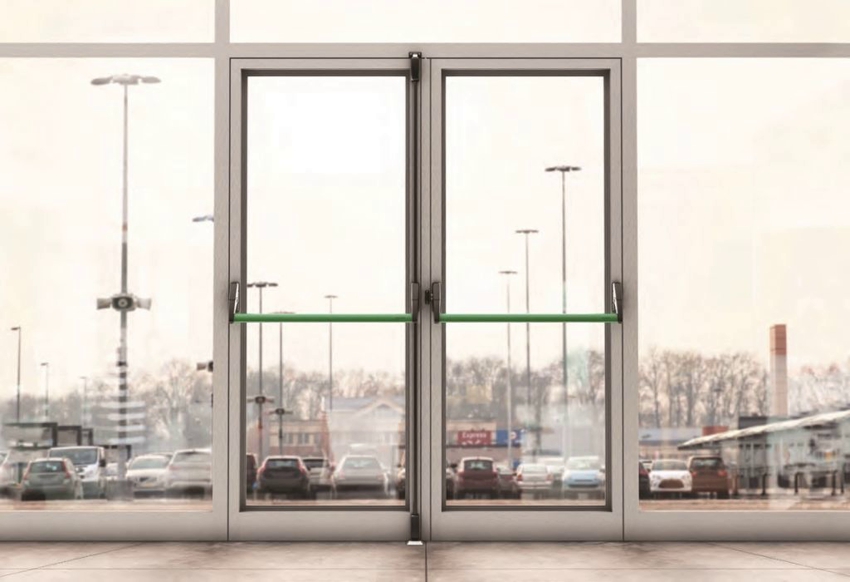
On the outside, the door is equipped with a conventional rotary handle, and on the inside - with a special anti-panic lever.
This system is a metal structure equipped with a lock. The locking mechanism reliably blocks the entrance from the outside using a key or automatic control unit. Thanks to this, unauthorized entry is excluded. At the same time, the device easily and freely opens the door from the inside of the room, just press the handle.
The structure is installed in an accessible and convenient place so that both children and people with disabilities or the elderly can open the door. There are dozens of variants of this system on sale. Its main parameters most often correspond to the dimensions of a standard door leaf.
Devices are classified according to the following criteria:
- purpose (for emergency or evacuation exits);
- installation method (on an active or passive sash, with and without rods);
- locking mechanism class (2-2, 4-4, 3-3);
- number of canvases (single-floor, double-leaf doors);
- door leaf weight (over 100 kg, up to 100 kg);
- additional functions (with and without security system).
Important! During fires, only 1% of people die from fire. The rest become victims of a massive crush or the poisonous effects of carbon monoxide. It is the prompt evacuation of people that avoids tragedy.
Advantages of using devices for emergency door openers Anti-panic
This locking system is universal, so it can be installed on any type of door structure. Moreover, both during their production and after the installation of the sash.
The advantages of using the system include such system capabilities as:
- Easy and quick response - prevents crowding at the exit, panic and crowding. The door can be opened with any part of the body, even if the hands are busy (knee, elbow, back). Allows you to accelerate evacuation and reduce the time of exposure of combustion products to people.
- Fire safety - the mechanism can withstand exposure to high temperatures and open fire, while maintaining its performance characteristics.
- Reliability and safety - due to a simple design, Anti-Panic systems rarely fail. The lock can be opened from the inside, even if the door is locked with a key from the outside.
- Additional features - connection of other access control systems. Some mechanisms open automatically when a fire alarm is triggered. It is possible to install microswitches, as well as a single blocking system for all outputs, which is controlled by a remote control.
- Protection against intrusion - from the outside of the building, the entrance remains securely closed.
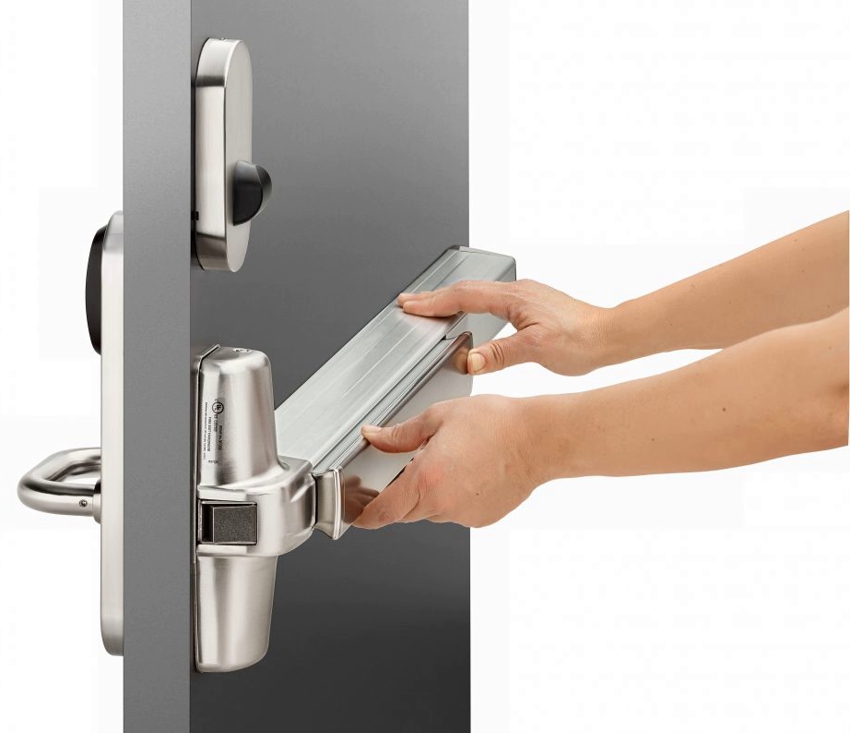
The Anti-panic system allows you to quickly open the door from inside the room, even if it is locked from the outside with a key
Scope of the Anti-panic system for doors
All emergency opening devices for emergency and fire exits are strictly regulated by the state standard 31471-2011. This document states that the door must be opened from the inside without a key. In this case, the entrance can be closed from the outside. The absence of fines is another advantage of using the Anti-Panic system.
The scope extends to any objects where an unhindered and prompt withdrawal of people in emergency situations is required. Most often, the system is installed on escape routes in public buildings. These points include emergency exits, emergency exits, and fire doors.
The main objects of use include the following types of buildings:
- business centers and office buildings;
- shops and shopping centers;
- educational and children's institutions;
- industrial and administrative buildings;
- cinemas, entertainment centers, theaters;
- sports complexes and swimming pools;
- waiting rooms in the premises of airports and train stations;
- hospitals and other medical institutions.
Note! The security system of emergency opening can be installed not only on metal fire doors. There are devices for window and door structures made of wood or PVC.
Anti-panic handle and other controls
The system can consist of two handles with a built-in cylinder. One of them is intended for external access, the other is installed on the door leaf from the inside of the room. The price of the Anti-panic handle depends on its design and configuration. In this case, the type of lock (mortise or invoice) and the number of fixation points (from 1 to 3) matter.
The handle is the main control element of the system. Its design is selected taking into account such conditions as the permeability of the room, the required degree of security from outside penetration, as well as the type of exit where it will be installed (evacuation or emergency).
The control elements of the system can be as follows:
- buttons;
- pens;
- rods, etc.
Each of them has its own peculiarities of use and operational requirements.
Reliability standards for fire doors Anti-panic
In addition to ease of use, other requirements are put forward for the handles, for example, reliability. Reliable locking systems meet high quality standards that set the acceptable parameters for door structures on emergency exits and escape routes.
The EN 1125 standard applies to doors where a horizontal handle system is installed. It can be in the form of a conventional crossbar or a structure called a push bar.
Such anti-panic devices are intended for people who do not have special training in case of danger, therefore they are installed at such facilities:
- theaters;
- museums;
- shopping and entertainment centers;
- stadiums;
- cinemas;
- fitness centers, etc.
The second standard - EN 179 regulates the parameters of emergency exits. In such cases, systems with keys, knobs and other control elements in the form of levers are installed. These constructions are intended for people who have received appropriate education and training. This category includes workers in factories and plants, office workers and other institutions.
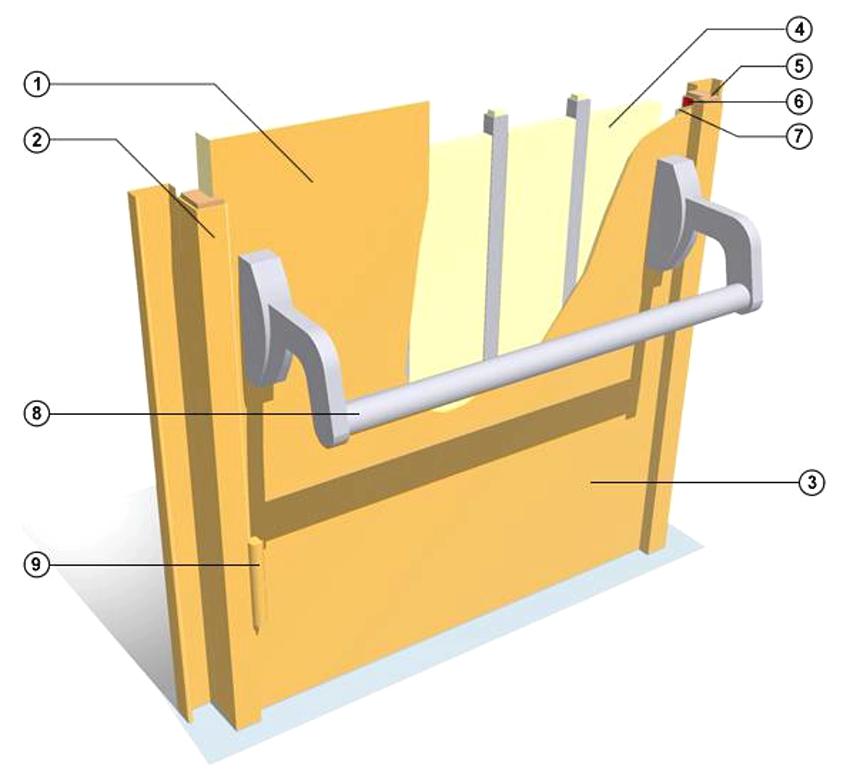
The structure of fire doors: 1 - a sheet of double cold-rolled sheet, 2 - a frame made of an all-metal bent profile, 3 - an external coating (painting), 4 - door filler (fire-resistant basalt plate), 5 - box filler (fire-resistant basalt plate), 6 - fire-retardant thermo-expanding tape, 7 - sealing circuit against smoke penetration, 8 - anti-panic system, 9 - steel hinges with thrust bearing
Note! With a small flow of people and low traffic of the room, you can install a system with an electric lock. The mechanism is controlled by a special exit button.
The main types of door handles Anti-panic: characteristics and material of structures
According to the standards, the existing types of handles can be divided into two categories. Devices belonging to the first group are intended for installation at emergency exits. These doors are not fireproof. The second group of devices is intended for door structures with such a certificate.
Common types of pens:
- Push handle, complete with an additional lock - recommended to be installed on doors with one or two leaves. Suitable for facilities such as theaters and educational institutions.
- The handle bar - consists of a tube with a round section, hollow inside. Used for quick evacuation from the premises, allows you to close the door so that smoke and fire do not spread.
- Fire door handle with additional security - the sash can be locked from the outside with a key, access is controlled by a latch.
- Key - installed on escape routes, is part of the security system.
Cost and materials of manufacture vary greatly. For the production of handles, aluminum, steel, plastic (individual parts) are used. It all depends on the type of door.
The price of an Anti-panic lock with a push-type handle will be cheaper than the cost of a system for fire doors with additional protection. For the production of the latter, steel or TsAM alloy is used.
Note! The product is covered with a special polymer dusting, which contains fire retardants. This slows down the heating process of the handle. The polymer coating protects the locking device from fire.
Fences and planks Anti-panic for checkpoints
Tripod turnstiles are installed at checkpoints. With their help, access to the protected area is controlled.Such devices are installed at the checkpoints of residential complexes, educational institutions, factories, as well as in the metro.
Antipanika turnstiles are of three types by design type:
- Suspended - mounted on walls and other vertical surfaces. This type of device is characterized by the most compact dimensions.
- Stationary - fixed to the floor with bolts.
- Pedestal - equipped with a massive rack that looks like a pedestal. Some models are equipped with glass.
According to the principle of action, they are mechanical and electromechanical. The second option is more convenient to use and functional.
The standard design consists of the following elements:
- stand and base;
- strips for blocking the passage (set - 3 pcs.);
- blocking lock (mechanical);
- an access control terminal for reading information from tokens or passes in the form of cards;
- remote control.
The turnstiles can operate autonomously (using the remote control or radio control device) or from the ACS (access control system). To get through the fence, it is enough to push the bar blocking the passage. The movement of this element is controlled by optical sensors. In case of fire and other emergency situations, there is an Anti-Panic function, which is connected to the security and fire alarm system. When an actuation occurs, the planks are fully lowered so that people can quickly leave the building through a free passage.
Anti-panic wickets, like tripods, are mechanical and electromechanical. These structures can be used alone or in combination with other fences. Wickets can be one-sided (provide access in one direction) or two-sided (open in both directions).
These structures are used to organize emergency exits from premises and evacuation routes. The wicket takes into account the needs of people with disabilities and provides free passage for unimpeded passage, as well as transportation of goods in emergency situations.
Important! The maximum allowed opening angle of the wicket door is 90 °. Exceeding this indicator can lead to structural failure.
Classification and device of door locks in the Anti-panic system
Locking mechanisms are classified according to various criteria. They differ in structure, mounting method, number of fixation points. At the same time, the lock is not the only active element of the system, it is always installed in combination with other types of fittings:
- regulators that control the opening process;
- chippers;
- door closers;
- sills;
- transoms;
- handles.
There are two types of locks in Antipanika systems: overhead and mortise. Each option has both advantages and disadvantages. Both systems are easy to use and versatile. They are combined with both mechanical and electromechanical locks. If desired, the opening process can be automated by connecting the devices to a central console.
Related article:
Fire doors: GOST on technical and operational requirements
Test methods, marking, types of structures. Manufacturing material, door classification. Fire resistance levels. Door blocks price.
Characteristics and advantages of overhead locks Anti-panic
Overhead structures are easy to install. Such mechanisms are predominantly in the form of latches. Screws are used for fixing. They fit almost any sash with standard parameters.
The overhead system can be installed on a door that is already in use. Such devices are mounted not only in crowded places.They are suitable for private sector facilities such as garages.
Anti-panic overhead kit for standard size doors (one leaf) includes the following components:
- locking part of lateral action (the element holds the crossbar);
- handle with built-in cylinder (cylinder) for access from the outside;
- crossbar.
If access from the outside is not required, the handle with cylinder can be excluded from this list.
Advantages of overhead devices:
- Simple and fast installation system.
- No plunging required.
- Fire resistance.
- Side and vertical locking of the sash.
Note! The overhead locking device does not belong to the category of power ones, therefore it does not have increased resistance to unauthorized entry. This is the main disadvantage.
A standard design means a door with one leaf and the following parameters:
- Weight - up to 200 kg.
- Width - no more than 1.32 m.
- Height - no more than 2.25 m.
The length of the overhead bar must be at least 60% of the sash width. The standard product variants that fit most door leaves are 1.13 m. If the sash is much narrower than standard doors, the crossbar can be cut to the required size. You can do this yourself. Longer rods can be ordered from the manufacturer if desired. Many companies manufacture products for door structures up to 3.4 m high.
Characteristics of mortise locks for fire doors Anti-panic: pros and cons
Mortise mechanisms belong to the category of locks with a module. They are characterized by high resistance to cracking.
Anti-panic flush kit includes:
- mortise-type locking device with anti-panic function (for free opening from the inside and reliable protection from the outside);
- cylinder (parameters are selected taking into account the thickness of the door leaf);
- crossbar with a set of special overlays for installation on the inside of the door;
- fire-fighting handle;
- split stem, due to which the outer and inner parts of the handle can work independently of each other.
A cylinder is usually built into the external access handle, which is designed for an English key. This option is reliable enough for use in normal operating conditions. If desired, the system can be equipped with more secret lock options if there is a need for increased burglary protection.
The advantages of mortise devices:
- Locking in two planes (lateral and vertical).
- The package includes a special lock.
- Cheaper than a waybill.
- Aesthetically pleasing appearance.
- Several points of fixation of the door leaf (from 1 to 3).
Installation is not easy to install. This requires specialized knowledge and the appropriate tool. Hidden in this design is a whole system that involves the installation of levers, rods and rotary handles.
The complex structure of the mortise structure not only creates difficulties in the installation process, but also prevents breaking. Unlike latches, modular locks are not easy to open. This takes much longer.
Note! If several anti-panic protective devices will be installed in the same building, it is possible to organize external access to all doors using one key. This system is called a master key. It is ideal for hotels and offices, but it can also be used at home.
How is Anti-panic installed on doors: double and single leaf
Overhead anti-panic on a standard door is installed according to the manufacturer's instructions. This process is straightforward.If at the entrance there is a door with two leaves, a set with fixing "floor-ceiling" is mounted on the second sheet. It works in conjunction with the main device. Both of these sets allow you to open each half of the door separately or both doors at once.
When the door is side-locked, the latch must engage in the counterpart. This element is included in the kit and is placed on the fixed half of the door. Therefore, two identical systems cannot be installed end-to-end. They just won't be able to work. Thanks to a set of devices with floor-to-ceiling fixation, the sash works normally. In this case, the stationary element is locked in the up-down direction, and the latch has a place to engage.
The floor-to-ceiling set consists of the following elements:
- crossbar;
- latches providing vertical locking;
- a locking device that acts in the vertical direction;
- rods with casing.
A three-point lock can be used to enhance the security of a single-leaf door. In this case, the obturator of the side-acting system is replaced with a universal obturator. The three-point locking device allows the use of both vertical latches and rods. As a result, locking is provided in two directions: vertical and lateral.
As for the mortise Antipanica, the standard version is selected for the movable sash, as for the single-door door, and the set for the passive door is as follows:
- cover plate for the mortise system;
- automatic locking device;
- crossbar (horizontal);
- mating part (top and bottom);
- mortise lock for fixed sash;
- guide for the mortise system (bottom);
- set of rods.
The choice of system does not depend on which side the sash opens (right or left). Combination of invoice and mortise Anti-panic is allowed. In this case, a set with fixing "floor-ceiling" in two places is mounted on the passive canvas. Mortise Anti-panic is installed in the active leaf. Thus, the door remains secure from the outside and opens quickly from the inside.
Thus, the carefully thought out and well-installed anti-panic system on the door is a reliable protective mechanism in emergency situations, which is paramount in the issue of rescuing and evacuating people.
